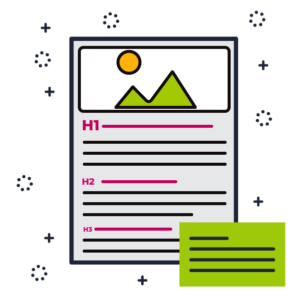
Have you ever thought about what it takes for a website to be considered SEO friendly?
When you invest time and money into building a website, the ultimate goal is to have it seen by your target audience, right? However, websites that are not built with SEO in mind may struggle with low visibility and poor conversion rates for an extended period of time.
This can result in having to hire SEO specialists to perform an optimization overhaul.
On the other hand, if you have a website that is built with SEO in mind right from the start, it can save you a lot of trouble. The well-optimized site will have much of the work done that helps you build your online presence more quickly and effectively.
By implementing key SEO components, you can transform your website into a search engine optimization and user-friendly powerhouse.
Key Takeaways
- SEO-friendly web design is essential for building a website for favorable search engine results. It enhances the user experience, with elements such as responsive design, security measures like HTTPS, and content usefulness being key factors.
- Key components of SEO-friendly webpage content include: strategic use of keywords, readability, user experience tailored to mobile devices, and strategic internal and external linking to provide value and context to the content.
- A strong website structure with clear information architecture, SEO-friendly URLs, and mobile optimization, is crucial for optimal search results. It should include technical aspects like fast page load speeds, meta tag optimization, and image optimization to improve search engine indexing and ranking.
Understanding SEO-Friendly: The Basics
SEO-friendly web design is a practice that serves a dual purpose: optimizing for search engines while enhancing the visitor experience.
When the Top Of The List team designs and develops a website for SEO, we focus on design and functionality. The goal is to streamline the user journey as well as lay a robust foundation for the website’s visibility (appearing higher in SERP rankings).
Embarking on the path to SEO-friendly design is not merely about adhering to best practices; it’s about embracing a mindset that places equal importance on the satisfaction of human visitors and the technical demands of search engines.
This approach is validated by an emphasis on content usefulness in Google’s E-E-A-T guidelines, where engaging and retaining readers is a significant goal. E-E-A-T guidelines are a testament to the importance of a well-rounded SEO strategy.
What Does SEO-Friendly Mean?
The term ‘SEO-friendly’ might conjure images of keyword-stuffed texts and manipulative tactics, but the reality is far from this outdated stereotype.
Being SEO-friendly means creating a seamless blend of user-experience, design, and technical optimization for both users and for search engines, particularly Google and Bing. When done right, it can lead to improved search engine rankings and a better overall experience for your site visitors.
To write SEO friendly content, it’s essential to create a website setup that eases the job of search engines in indexing content, grasping the site’s theme, and featuring it prominently in search results pages. It’s the digital equivalent of laying out a welcome mat for both search engine algorithms and visitors, inviting them to explore and easily understand your content.
This approach to web design is indispensable because it ensures that sites are not just simple to access and navigate for users but are also structured in a way that allows Google and Bing to efficiently crawl and index the site’s content.
By marrying accessibility with navigability, websites created with search engine optimization foster a relationship between web users and search engines, creating a seamless experience for both.
Why is SEO-Friendly Important?
Diving into an SEO-friendly design opens up many aspects of digital marketing for both users and search engines. The approach amplifies a website’s accessibility and indexability, propelling higher traffic volumes and making your digital presence more pronounced.
The ripple effect of SEO-friendly design is profound – it not only makes your website easy to find but also ensures that once users land on your pages, they are welcomed with an experience that encourages them to explore and engage.
Ranking high on SERPs (search engine results pages) is similar to having a prime brick and mortar location. It increases visibility and brings in more traffic, converting potential visitors to loyal customers.
Websites optimized for search engines are more likely to enjoy these benefits. They appear higher in search results and capture the audience’s attention when they are searching for something the site provides.

Key Components of an SEO-Friendly Website
In the following sections, you’ll learn the different steps to building an SEO friendly website from the foundation to the finished product. Here are the key components:
- Website Structure & Design
- Architecture
- URL Construction
- Responsive Mobile Design
- Technical SEO
- Page Speed
- Sitemaps
- Meta Tags
- Images
- Structured Data
- Content Optimization
- Keywords
- User Experience
- Types of Content
- Links
- Content Relevance
- Headings
Step 1: Best SEO Practices for Optimizing Website Structure
As an architect meticulously plans the blueprint of a building. So, too, must a webmaster consider the structure of a website. A simple, yet well-thought-out website architecture is the foundation upon which SEO success is built.

Information Architecture
The essence of information architecture lies in its ability to:
- Organize the chaos of content into a coherent, easily navigable structure
- Categorize and connect content in a way that makes sense to users and search engines
- Direct users to the information they seek
- Signal to search engines the importance and relevance of each page
A well-planned information hierarchy achieves all of these goals.
The brilliance of good information architecture is that it not only simplifies the user’s quest for knowledge but also aids search engines in their understanding of your website’s content. It’s an elegant dance between clarity and complexity, where each step is purposeful and every turn is intuitive.
By creating a sitemap, you lay out a roadmap for search engines, ensuring that they can effortlessly traverse your digital landscape and index your pages with precision.

URL Structure and Context
An SEO-friendly URL is not a cryptic code but a clear indicator of the page’s content, enhancing usability and readability for all who traverse your digital domain. The use of simple, descriptive words in URLs not only aids human visitors but also assists search engines in understanding your site’s structure.
Beware the never-ending URL! Try to keep the length at a four-word max if possible. All too often blog post URLs are automated to include every word of the page title in its URL. Choose the most important terms in your title to use for your URL.
For example: if your blog page title is “How to Create the Best Vacation Plans: A Guide to an Amazing Voyage”
Do not make this your URL: yourwebsite.com/blog/how-to-create-the-best-vacation-plans-a-guide-to-an-amazing-voyage
Instead, consider this for a simple and SEO friendly URL: yourwebsite.com/blog/best-vacation-plans
Each URL should offer a concise, contextual glimpse into the page’s narrative. Hierarchical structures within URLs provide a natural flow, allowing search engines to discern the relationships and relevance among various pages.

Mobile-Friendly Design
In the era of mobile phones and tablets, a mobile-friendly design is not just a feature; it’s a necessity. With Google’s mobile-first indexing, the mobile version of your content takes center stage, becoming the primary source for indexing and ranking.
Websites that embrace a responsive design are rewarded with not just a nod from search engines but also the appreciation of mobile users who demand a seamless experience on their handheld devices.
So make sure your content is user-friendly on all screen sizes, especially mobile devices, by choosing a theme that is mobile responsive and testing different screen sizes before launch.
Step 2: Technical Aspects of SEO-Friendly Websites

Beneath the surface of every SEO-friendly website lies a network of technical elements, working in unison to ensure the site’s content is accessible and visible to search engines. Ensuring that search engines can fully index the content on a website is essential for search engine accessibility and visibility.
Tips to Avoid Common Obstacles
Common obstacles can hinder search engines from indexing important website content, undermining SEO efforts. Examples include:
- Hidden content behind pop-up windows
- Misuse of ‘noindex’ meta tags
- Improper syntax use in a site’s .htaccess file
- Misuse of canonical tags
- Redirect chains or other issues
Technical aspects that affect the user experience on mobile devices are also commonly seen. Examples include:
- Tap targets (links and buttons) are too small for a finger to activate it
- Links and buttons are too close together
- Font sizes uncomfortable for reading on a small device
- Line spacing disrupts reading flow
- The color pallet’s contrast is too low for low vision users
- Link colors are difficult to see, or worse, not visible, when compared to default body text color
- Transcriptions for videos and captions for audio features are not provided, making the mobile version unfriendly for accessibility reasons
Review your site for these common obstacles, or ask your developer to do so. Fixing them can make a positive difference to your site’s users and its visibility.

Page Load Speed
The speed at which a web page loads can be the difference between a visitor who stays and one who leaves in frustration. Fast websites are not just user-friendly; they guard against visitors bouncing from the site, preventing potential revenue loss and elevating search rankings.
At the core of page speed is the software that runs the website, its theme, and any other software that’s been added to provide ‘easy to implement’ features.
An 8-cylinder car will likely go faster than a 4-cylinder car. However, adding weight to the car, choosing its tires, and designing its airflow can significantly affect speed as well. This analogy is much like that of a website. Fast core and theme software must be decided at the beginning.
Beyond that, adding plugins and modules to speed up development can significantly slow down the site too, resulting in a painstakingly slow loading site. All must be chosen with care, by a developer who is knowledgeable about page speed.
A minimal way to improve page speed for SEO optimization is by reducing the size of images. Tools such as Google PageSpeed Insights provide Google’s Core Web Vitals to measure user experience and website speed.
While it also includes technical details about what may be slowing the site’s load and response time, they are complex and not always repairable. Unfortunately, after a website is built is not an opportune time to improve page speed. Speeding up a slow site can be a lengthy, expensive, and complex process that is much more efficient to address at build time.
Digital Sitemaps
Just as a map guides travelers through a physical landscape, a digital sitemap serves as a compass for search engine crawlers, showing them to the most important content on your website and improving the efficiency of their crawl.
This same optimization process is especially beneficial for sprawling websites, where the sheer volume of content can obscure the highlights within. A sitemap brings deeper content to light, ensuring that no page is left abandoned and that every piece of content is connected. It’s about creating a clear, navigable path for search engines, one that leads them through your website with ease.
Ensuring websites possess a digital sitemap is yet another component of website SEO and making the site more inviting to search engines.

Meta Tags and Meta Descriptions
A website’s meta tags and descriptions are a user’s first impression of your website content on organic search engine results pages. Title tags, in particular, hold sway over both search engine rankings and user interactions, as they are the first glimpse users get of what your page has to offer.
Description tags, though not a direct SEO ranking factor, give a viewer a bit more information about your page to entice searchers to click, providing a brief preview of your page’s content.
To craft a compelling meta description, you must be concise, and rich with meaning, to capture the essence of your content in a mere 160 characters or less. Headlines and descriptions equipped with the right keywords increase visibility on search engines and draw users in with the promise of content that fulfills their search queries and ignites their curiosity.

Image Optimization
Image optimization is another element in the SEO arsenal. Google requires assistance to identify images, making descriptive file names and alt text indispensable for search engine recognition. These labels are not just for search engine understanding but are critical for the site impaired, who cannot see what is in a picture or on a button. Instead, their browsers verbally tell them the contents.
It is a very poor practice to stuff alt attributes with keywords for the sake of SEO, and not describe the contents of the image to potentially blind readers.
To improve the loading speed and SEO of your website, modifying or deleting the image metadata is an option, especially if your site has thousands of images.
Schema Markup
Schema markup is a powerful code that is written specifically for machines, helping them to understand, form relationships, and display content more effectively in search results. This structured data can elevate your content in search results by encouraging search engines to create Rich Snippets from the details it pulls from schema.
As AI becomes more prominent in our everyday use, it is essential to provide data that can quickly and easily be read and interpreted by machines. By marking up website pages with schema you’re setting your business up for improved organic and voice search performance.
Step 3: Content Optimization Strategies for SEO-Friendly Results

When it comes to website SEO, content is King. Understanding the search intent behind keywords aligns your quality content with the queries and needs of potential consumers.
This alignment ensures a harmonious match between your content and user expectations, which not only satisfies their search purposes but also elevates your search rankings, leading to a win-win scenario for all involved.
Creating content that resonates with both search engines and users is not unlike crafting a fine wine; it requires patience, skill, and a deep understanding of the ingredients – in this case, relevant keywords.
By targeting these keywords in harmony with search intent, you concoct a potent blend that appeals to the palate of your audience and the sophisticated taste of search engines.

Keyword Research and Usage
In keyword research, it is important to hone in on which specific words or terms your target audience is searching for so you can tailor your content to meet those needs.
Put yourself in your customer’s shoes and brainstorm all of the words they would use to search for your products or services. Once you have a list you can use online tools to see which related keywords are high in search volume.
There are many tools available to conduct keyword research on topics including MOZ Keyword Explorer, Google Keyword Planner, and SEMrush Keyword Magic.
Once you have primary and secondary keywords chosen for each of your pages, you’ll need to write content for them or place them into existing content.
Make sure to keep balance in mind by paying attention to keyword density to avoid keyword stuffing, which Google frowns upon. Overstuffing keywords not only triggers Google that you’re trying to cheat the system, but it also sounds bulky and makes it difficult for the user to read. Strategically place keywords throughout the page so they are not all concentrated in one area.
Also use a diverse set of terms, that are similar but not exact to your targeted keywords, for crafting a narrative that is both compelling and SEO-friendly.

Readability and User Experience
No SEO-friendly website is complete without the presence of readability and user experience. Readers want content that flows smoothly, guiding them effortlessly through the information.
High readability scores are like a magnet, drawing visitors deeper into your content, increasing engagement, and encouraging them to linger longer on your pages, which search engine algorithms favor.
Make sure to keep your content legible on smaller screens and mobile devices by adhering to the technical tips above. By putting yourself in the user’s mindset, you can create content that has enjoyable subject matter and is physically pleasant on the eyes for reading.
SEO-Friendly Content
The key components of SEO-friendly website content form a complete picture that both users and search engines can appreciate.
The internet is an ocean of content. Standing out requires not just creativity but also strategic alignment with SEO principles. Thus, it is essential to write high-quality, valuable content that includes a target keyword and other related terms. This helps to ensure placement in organic search results and also helps the content be found by those who desire to learn about it.
Have you noticed the difference between the landing pages that you exit out of quickly and those that you stay on and even click deeper into a site? SEO friendly content is created by writing relevant content that is engaging, educational and helpful to your users.
It also needs a strategy including keyword research, determining user intent, linking, and follows quality content guidelines.
Some examples of content types that are engaging and SEO friendly are:
- Services pages with
- infographics
- images
- clear headings
- shortened paragraphs that flow well
- follow a marketing funnel based on the visitor’s persona
- E-commerce product pages with
- clear images and product titles
- demo videos
- diagrams
- specs and measurements
- helpful descriptions
- Blog pages that contain
- images
- lists or tables
- references and links that verify statistics
- comparisons
- step-by-step instructions
- definitions

Internal and External Linking
The web is a labyrinth of information with internal links and external links connecting one piece of content to another. Internal links are the pathways that guide visitors to other parts of your website, creating a network of information that is both enriching for the user and invaluable for search engine crawlers.
It is important to choose descriptive anchor text for your internal and external links. Descriptive anchor text is a set of words that you choose for your links, and it related to the page it’s on as well as accurately represents the page it points to.
When you sprinkle descriptive anchor text for internal and external links throughout your content, the links act as signposts, providing clarity and context for both the user and the search engine.
Venturing beyond the borders of your own domain, external links are the bridges to other areas of information, enriching your content by offering additional information or verifying statistics. They allow users to explore further, validate sources, and research the broader context of your narrative.
This act of linking outwards is not just an exercise in generosity; it’s a strategic move that search engines recognize and reward, as it enhances the overall value and credibility of your content.

Writing Engaging and Informative Content
To write content that truly engages and informs is to paint with words, creating a masterpiece that captures the essence of your target market’s interests or queries. Original content, whether it’s videos, infographics, or whitepapers, hosted on your own domain name, can act as a beacon.
Authentic, relevant content throughout your website sets up valuable web pages to draw in more organic traffic and establishes your brand as a thought leader in your industry.
Engaging content contains relevant keywords and a consistent structure that guides readers through your narrative, establishing your expertise.
Targeted keywords add a layer of texture to your content, bolstering its relevance and ranking on search engines. Linking those keywords with relevant outbound links provides value and context that enrich the user experience and contribute to the informative quality of your content.

Using Headers and Sub-headers
In webpage content, headers and subheaders are used to support clarity and organization. Search engines understand a clear hierarchy of headings.
Using H1 for the main title and cascading down through H2 and H3 for sections and subsections structures content effectively and supports navigation. Using headings enhances readability and allows users to skim through content and read what they are most interested in.
The art of using headers and subheaders is to capture reader intrigue and maintain engagement. Powerful words, emotional triggers, and thought-provoking questions can transform headings from mere labels into compelling invitations to explore further.
By striving for clear and concise headings, you create pockets of white space that offer readers a moment to breathe, enhancing the overall readability and appeal of your content without the clutter of unnecessary punctuation.
Avoiding Common SEO Pitfalls

One SEO misstep can have a cascading effect on your website’s search engine rankings. A large pitfall is content duplication it’s essential that each page on your website offers unique content.
Spammy and copied content on your site can get it penalized by search engines like Google, which have a zero-tolerance policy against duplicate content.
The quest for SEO-friendly content is not just about what you include, but also what you avoid. Providing fresh, unique content for each page will ensure that your website remains in the good graces of search engines.
In summary, it takes knowledge of SEO and website design and development to properly create an SEO-friendly website. Achieving a high-ranking website involves much more than a collection of keywords and link-building strategies. It is a complex task that seamlessly combines the art of creating a user-friendly experience, technical intellect, and content optimization skills.
Use these insights as you craft your website, or contact the SEO Experts at Top Of The List for SEO-friendly website design and development services.

Rachel Eager
Marketing Strategist, Top Of The ListRachel, armed with a BFA in Graphic Design from Grand Valley State University, is a seasoned marketing professional known for her expertise in both traditional and digital strategies. Her technical prowess extends to web design and content creation, and she’s driven by a passion for helping businesses reach their target audiences. In her leisure time, you’ll find her enjoying outdoor activities like kayaking and motorcycle riding.

Nicole Vesota
Vice President & Project ManagerNicole has been working in online marketing since 2007 when she joined Top Of The List. She loves creative endeavors and spending time with her daughter.

Bev founded Top Of The List in 2006 and has over 25 years of experience working with technology. In her free time, she competes in dog agility competitions with her Golden Retrievers, Cosmo, and Finn.




